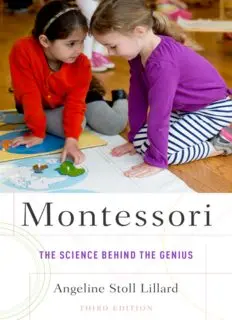
Montessori : The Science Behind the Genius PDF
Preview Montessori : The Science Behind the Genius
i Montessori ii iii Montessori THE SCIENCE BEHIND THE GENIUS THIRD EDITION Angeline Stoll Lillard 1 iv 1 Oxford University Press is a department of the University of Oxford. It furthers the University’s objective of excellence in research, scholarship, and education by publishing worldwide. Oxford is a registered trade mark of Oxford University Press in the UK and certain other countries. Published in the United States of America by Oxford University Press 198 Madison Avenue, New York, NY 10016, United States of America. © Oxford University Press 2005, 2007, 2017 All rights reserved. No part of this publication may be reproduced, stored in a retrieval system, or transmitted, in any form or by any means, without the prior permission in writing of Oxford University Press, or as expressly permitted by law, by license, or under terms agreed with the appropriate reproduction rights organization. Inquiries concerning reproduction outside the scope of the above should be sent to the Rights Department, Oxford University Press, at the address above. You must not circulate this work in any other form and you must impose this same condition on any acquirer. Library of Congress Cataloging- in- Publication Data Names: Lillard, Angeline Stoll. Title: Montessori : the science behind the genius / Angeline Stoll Lillard; photographs by An Vu. Description: Third Edition. | New York : Oxford University Press, [2017] | “Translated from the Italian by Claude A. Claremont”— T.p. verso. | Includes index. Identifiers: LCCN 2016012465 | ISBN 9780199981526 (hardcover : alk. paper) | ISBN 9780199981533 (UPDF) | ISBN 9780199981540 (EPUB) Subjects: LCSH: Montessori method of education— United States. | Montessori, Maria, 1870– 1952. Classification: LCC LB1029.M75 L53 2016 | DDC 371.39/ 2— dc23 LC record available at http:// lccn.loc.gov/ 2016012465 9 8 7 6 5 4 3 2 1 Printed by R.R. Donnelley, United States of America Excerpts from THE ABSORBENT MIND by Maria Montessori. Translated from the Italian by Claude A. Claremont. First published in the United States in 1967. Reprinted by permission of Henry Holt and Company, LLC. Frontispiece image of Maria Montessori: Courtesy of the Archives of the Association Montessori Internationale, Amsterdam, Netherlands. v For Bill, Chaney, and Jessica vi vii CONTENTS First and Second Edition Preface ix Third Edition Preface xi Acknowledgments xiii Notes on the Book xv 1. An Answer to the Crisis in Education 1 2. The Impact of Movement on Learning and Cognition 37 3. Choice and Perceived Control 81 4. Executive Function 105 5. Interest in Human Learning 137 6. Extrinsic Rewards and Motivation 177 7. Learning From Peers 219 8. Meaningful Contexts for Learning 251 9. Adult Interaction Styles and Child Outcomes 283 10. Order in Environment and Mind 315 11. Recent Research on Montessori Education 351 12. Education for Children 377 Works Cited 399 Author Index 447 Subject Index 461 viii ix FIRST AND SECOND EDITION PREFACE Twenty years ago, I was a Montessori skeptic. I had taken a Montessori teacher training course and was frustrated at not being able to discriminate scientifi- cally supported ideas from mere opinion. I had met Montessori teachers who sometimes came across as more devoted to upholding their heroine than to learning about children. And I was convinced that while Montessori surely had its strengths, traditional and other forms of education surely had theirs too, and the best educational system would combine the strengths of each system. When I embarked on graduate study in developmental psychology, I occa- sionally came across a study that happened to reiterate a major principle of Montessori, and I had seen enough of such studies by the time I had chil- dren to want them to be in a strong Montessori school if I could find one. (Not all Montessori schools would qualify, for reasons that will become clear in this book.) Having my children in a Montessori school led me to study Montessori practices more deeply, and I saw more convergences with research over time. The education director at my children’s school, Trisha Thompson Willingham, asked me to write a column about these convergen- ces for the school newsletter, and from that column this book was launched. The delegates at Oxford University Press asked that I write a balanced assessment of Montessori, pointing out where the evidence is not support- ive as well as where it is. I have done my best to do this, but there is a real problem. Their assumption, like my original one, was that Montessori must have aspects that are supported by research, and aspects that are not. Yet her major ideas— that there is a close relationship between movement and cogni- tion, that the best learning is active, that order is beneficial for children, and so on— are supported by a strong body of evidence in developmental psychol- ogy. Some of her main developmental ideas that did not take hold until later and are rarely attributed to her are now mainstream, such as that children go through sensitive periods in development, and that language is (in a sense) innate. None of the Montessori ideas that I would consider central have been “disproven.” Others are not researched. The most major idea that is not sup- ported by the evidence is her negative view of pretend play, which I discuss at the end of c hapter 5.1 Like Piaget and others of her time, Dr. Montessori saw adaptation to reality as the goal of development, and pretending as a frivolous expression of immature minds that were not adapting to reality. 1 In this third edition I retract this; see end of Chapter 6. ix
